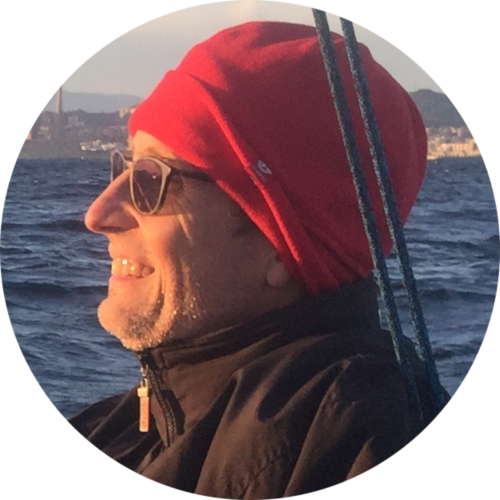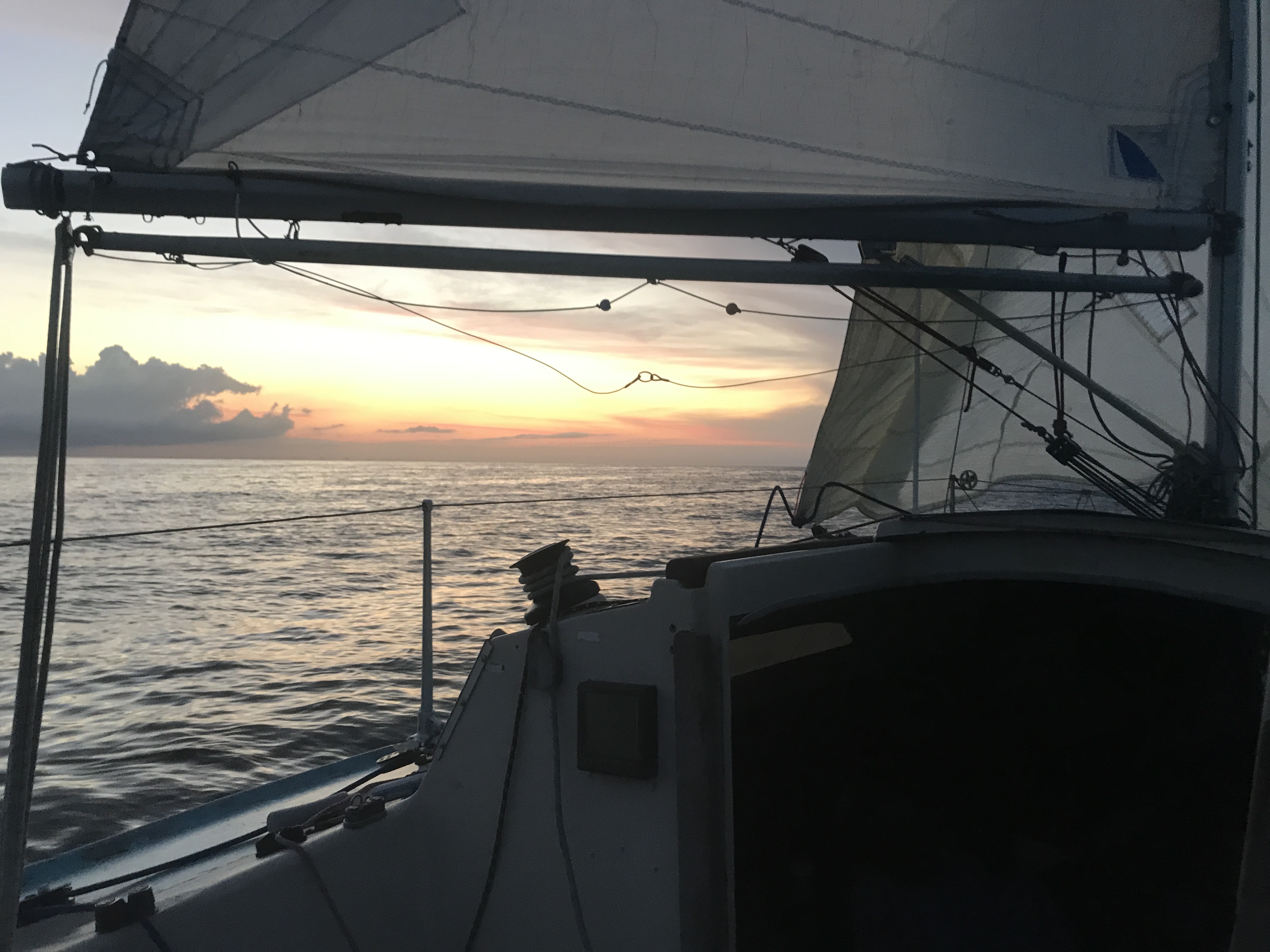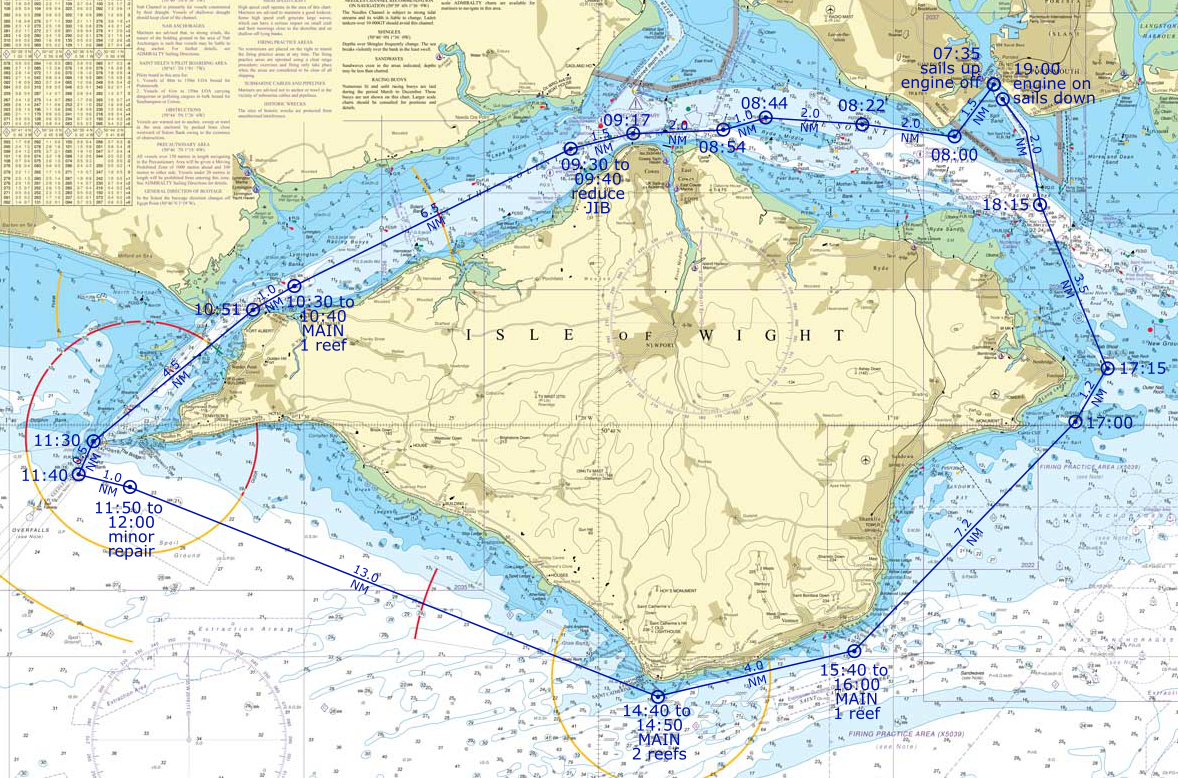I am learning solo sailing by doing it.
That’s why I planned an entire season of sailing in safe waters.
To make all the possible mistakes.
And learn from them.
I was dangling out of the boat on the portside, with my lifejacket on and attached to a halyard, a rope used to hoist sails on the mast, pushing with my feet on the side of the boat to get as far out as I could.
“This is my last resort!”
Thanks for reading One & Ocean ! Subscribe for free to receive new posts and support my work.
A light wind was blowing from the opposite side, heeling the boat in the same direction. I always wanted to check whether my weight at the top of the mast would be enough to capsize the boat, but this was not the right occasion to experiment.
“I can’t give up now!”
The engine was roaring at full throttle and would dangerously overspeed every time the propeller got out of the water.
“Come on, come on!”
Moments earlier I needed to find a way to heel the boat. Standing on the side would not do it. I needed to get more leverage. That’s when I thought to put my life jacket on and dangle while attached to a halyard.
“I won’t give up!”
It was beautiful to fly over the waves and see the water flow under my feet, yet I didn’t have the time to appreciate it, the engine was suffering and the heeling was not enough.
Then the engine overheated and died.
“Yawn! Good Morning!” It was the first night out on my new small sailing yacht. Just 22ft. 6in. or less than 7 metres, yet a nice boat with 2 big bunks and a small galley. At 4am the light was winning the night and I was readying for a good day sailing.
The day before I went to sleep at sunset after a nice sail. I was approaching a difficult passage so I decided to stop there and wait for the next day to cross it. The passage was between land at South and a big sand bank at North. Just 1 mile wide yet well marked by buoys.
To be honest, the day before did bring some challenges. The sea was a bit choppy and I got slightly seasick, so in any case stopping for a few hours of sleep was in order.
It was not a calm sleep though. I woke up in the middle of the night with nightmares. Yet when I opened my eyes after the nightmares I could see a beautiful scene. Imagine to see the night sky framed by the companionway, and in the frame all of Ursa Mayor, the Plough.
The sun rose at around 4:20am when I set sails and reached the first buoy of the narrow passage, which runs West to East along the coast. Sailing Eastward at that time of the day meant sailing into the sun, so beautiful! I couldn’t see the next buoy but from the chart I could tell the exact course I needed to follow.
The day before I did the same to step between buoys laid far apart and I perfectly hit the mark! I was very satisfied with my seamanship. Nothing more than setting a course and keeping sailing straight in that direction.
Plus, this morning the wind was with me and the tide just turned to ebbing, also pushing me in the right direction.
I felt bliss. The first sun rays warmed my face in the chilly morning air. The wind blew gently from behind, filling the sails and pushing me and my boat forward. The sound of the bow in the water, cutting its still surface and making little diverging waves.
Being at the helm felt great! The compass in front of me, showing the right direction. That’s what peaceful sailing is all about!
The air was so hot that woke me up. I found myself wedged between the bunk bed and the side of the hull. So uncomfortable!
Winning my resistance to stay in bed, I climbed out of the bunk. Climbing is the right word because the cabin around me was tilted 45 degrees to the side and the companionway was high up.
I needed to step on my bunk which was on the lower side of the cabin, then on the other bunk on the higher side, then finally on the companionway’s threshold to peek my head out in the blazing sun.
Not a sound out there, all quiet. No noise of wind, neither of water.
Several hours later some wind picked up and I found myself sailing slowly against the tide and towards the buoy. Ah the buoy! I could finally see it! It was 1 mile South of my position.
The scratching noise was finally subsiding and the sailing went smooth. It took me over an hour to get to the buoy. In calm waters objects appear closer than they are!
That scratching noise. What a nightmare!
It started 6 hours earlier, while I was blissfully sailing into the sun and following the course from the first to the second buoy.
Scraatch! And a sudden jolt shaking the entire boat. “WTF! it feels like I’m scratching the sandy bottom.”
“Quick! Think! Quick! How come I’m scratching the bottom? Am I grounding? No it can’t be, I’m sailing in the right direction towards the next buoy marking safe waters.”
Scraaatch! Jolt! “Yeooow! It can’t be!”
I must have drifted slightly to North and I’m likely to be shaving the side of the sandbank to the North of the passage. So much for blissful sailing! Let me steer to starboard, that is to the right, heading more to the South.
Scraaatch! Jolt! Jolt! Scraatch!
Of course! The tide is ebbing so the water level is reducing fast, more to the South, and let’s switch on the engine to sail faster to safety!
Wroumm! Full throttle. Heading decisively South, at 90 degrees to the right from my original course.
Scraatch! Scraatch! And then scraatch! There were no jolts any more, just a single bumpy ride.
“Quick! There’s no time to check position on the charts, I need to reduce the boat’s depth.”
The lifejacket has a hook on the front to attach to safety lines. Let’s use it to attach to a halyard and try to heel the boat so that the keel gets a bit higher and clears the ground.
To no avail. And eventually the engine gave up. Worse than a nightmare!
What kind of bottom is here? Will I break my boat on the second day of navigation? And what if the bottom is mud? Will the boat sink into the mud? And when the tide flows again, will the boat right itself before the water is high enough to start flowing on deck and into the companionway?
Whatever. I have no choice. Live with the fact that I have hit ground and the tide is still ebbing.
Wait! I see the bottom, not even a metre below. It’s sand. Good news. Let’s just stop the boat, drop the sails and stow them so that they don’t fall into the water.
The boat is heeling to the port side, the keel firmly sunk in the sandy bottom. All is quiet. Let’s check the position on the GPS. Damn it, I should have checked before and marked my position on the chart as any good sailor would, out of good seamanship.
The GPS station was there, 3 metres from me, inside the boat at the charting table. The chart was also there. Unreachable. Without autopilot or wind vane, the boat wouldn’t keep the course if I left the tiller unattended. Even tying to the centre position would not work, I already tried it in the past.
Essentially, I was tied to the tiller without a chance to do anything else.
Big lesson that I will remember forever. Always know where you are, particularly in difficult waters. Sounds obvious. What to do about it? Get an auto pilot? Yes, it will come some day. For now, better passage planning for sure.
Getting to the first buoy and keeping a course from there was a decent idea, if it weren’t for… the ebbing tide. I assumed the tide would be running along the coast and the channel, but clearly there was a strong component sideways, away from the coast and across the submerged sand bank.
So while keeping my course correct, I was actually sliding sideways to the North and I ended up on the other side of the sand bank! But without my exact position how would I know it? Then the ebbing tide did the rest, gradually reducing the water depth everywhere. That’s why sailing South was the worst choice I could make. It meant sailing exactly towards the highest part of the sand bank.
Another instrument that could have helped is a depth meter. I had one installed but for some reason it was not working, same as the speedometer or speed log. So I was basically without instruments.
The boat was firmly laid on the seabed, now just a few centimetres deep. Time to take some rest. She was heeled 45 degrees to port, so I created a cosy wedge between the port bunk and the hull side where I could rest for a few hours.
I laid down in my makeshift bed. And I slept. And I dreamt.
Long ago I saw a documentary on TV about the hundreds of calls that the RNLI receives every year to save people stuck in quicksand with a flowing tide that will submerge them in a few hours if no one comes to rescue. Apparently quicksand is rather common in the sandy and muddy British seabeds.
I had a nightmare of myself stuck in quicksand just a few metres from my boat, with my mobile on board and without any chance to free myself before the tide flows in again. A nightmare at noon in a hot boat! And I woke up.
Out on deck again, I was surrounded by a sea of sand. at least half mile in each direction. I was at the top of the sand bank!
I decided I should take advantage of the situation to try and repair the failing instruments, plus clean up the hull from seagrass. Will it be safe? Was the nightmare a good way of reminding me to do it safely?
I tied myself to the boat, with my mobile in a watertight bag around my neck. And put one step down on the sand. Hard sand. Now the next. Hard again. Now stand up. Nothing. That’s good. A few steps, always making sure that the new step wouldn’t be in quicksand. Nothing. Phew!
At that point I had just half an hour before the tide would flow back, so quickly, clean the hull. Check. Now repair the speed log wheel. Check. Finally clean the area around the depth sensor. Check.
The water was crawling fast from all sides toward me and my boat. I enjoyed the first contact with it and then stepped on board.
Prepare to hoist the sails. Clean up the deck. Wait for the boat to be upright again.
And there it was, the buoy that I could not see.
Later the wind picked up and I was on my way again. Some more scratching noises but now I knew what it was and that it would end soon. Free again to sail solo to my next challenge!
A huge thank you to Mike Sowden of Everything is Amazing here on Substack. This is my task for lesson 3:3 of his online course Engage! I.e. my first attempt to write something that is not plain dull!
Originally published on the One & Ocean channel on Substack https://oneandocean.substack.com/p/bliss-and-nightmares



